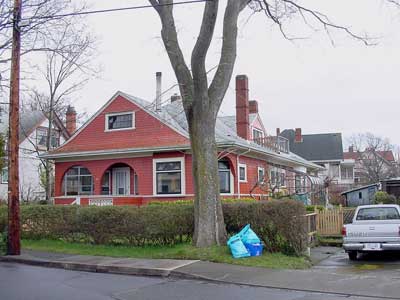Heritage Register
James Bay
23 Paddon Street (ex-23 Dallas Av)
Built
1906
Heritage-Designated 2001
For: Ethel & Charles Smith
Architect/Contractor: attributed to George C. Mesher & Co

ARCHITECTURE:
This 1½-storey, hip-roofed, shingled bungalow has a wide, flared, dominant front gable over the entry porch on the left and an angled bay to the right. A very narrow, shed-roofed box bay sits on the front angled bay. There are gabled dormers on either side; none of the three gables has eaves; the front and left gables have multi-light, awning windows; and the gabled dormer on the right, over an angled bay, has been modified to accommodate a balcony. The side-facing steps with sawn A&C balusters lead to a landing with solid balustrades interrupted by a panel of sawn balusters. The entry porch, which has three unusual rounded arches, opens off the landing. Many windows are diamond-paned, leaded lights. The foundation is of rubble, and four original chimneys, with unusual brick banding, survive. The fluid treatment of the shingled surfaces is an original feature of this house, which anchors the east side of this streetscape of shingled houses.
ORIGINAL OCCUPANTS:
Ethel and Charles Smith owned this house until at least 1916, living here until c.1914. Charles was born in Manchester in 1871 and came here c.1900 after living on the Prairies about 10 years. Ethel Easthope was born in Wolverhampton, England, in 1879 and came here in 1901 after her marriage in Vancouver. Charles established a picture framing and retail business in the Five Sisters Block, later at Broad and View Sts. He retired several years before his death in 1947. Ethel died in 1974 at 95.
OTHER OCCUPANTS:
Horatio Ravenhill and his sisters Edith and Alice lived here from 1921-34. They arrived on Vancouver Island from Essex, England, in 1910. Horatio first settled at Shawnigan Lake with his sisters and his only son, but his son was killed at 26 at the Second Battle of Ypres in 1915. Horatio and his sisters then came to Victoria. He was educated at Marlborough College, played amateur tennis and won national and international matches with Marlborough Nomads Football Club.
A proponent of social welfare, he contributed to the Community Chest program for 25 years, and was a founding member of the Social Service League. Horatio was a member of the Navy League, Overseas League and British Public Schools Clubs. The loss of his son affected him greatly, and he became involved with boys’ organizations. As commissioner of Boy Scouts for Vancouver Island, he acquired the affectionate nickname “the squire.” Horatio was an avid cyclist. In 1935 at 73, he cycled across Canada from Matapedia Valley, NB, to Vancouver in just three months. He died in 1941 at 79.
Edith and Alice never married. Edith died in 1953 at 92. Alice was born in 1859. In the late 1890s, the National Health Society began training women to go into rural factories to improve the deplorable living conditions. Alice was one of the first four to enroll. In 1901, the British Board of Education sent her to the USA to assess university courses on home economics. Alice was then appointed home economics lecturer at King’s College, University of London, the first woman to lecture there, a considerable feat with no degree.
Before coming to BC in 1910, Alice became the first female Fellow of the Royal Sanitary Institute for her promotion of hygiene and public health. She made frequent lecture trips to the USA, and was director of home economics at Utah State College from 1917-19. In 1913 she gave the inaugural speech at the opening of the University of Toronto Women’s Building. Upon retiring in 1919, Alice settled in Victoria, where she enjoyed needlework and other arts. She joined the Women’s Institute and other organizations, promoting food preservation, childcare, and other concepts to women around the province. In the 1920s, she helped establish Queen Alexandra Solitarium for Crippled Children (now the QA Centre for Children's Health).
By 1928, Alice had developed an interest in native arts and crafts and became a leading authority on West Coast Tribes. In 1939 she established the Society for the Futherance of BC Indian Arts and Crafts, later known as the BC Indian Arts and Welfare Society. She wrote one of the first textbooks used in elementary school curriculum called The Native Tribes of British Columbia (1938), and other books on aboriginals and her own life. In 1948, Alice was bestowed an honorary doctorate in science by UBC. The following year, Prime Minister Louis St Laurent visited her to commend her on her life’s work; she took the opportunity to promote aboriginal rights. In 1953, she was awarded a Coronation Medal. Alice Ravenhill died in 1954 at 94.
Marian (Bolton) and William Thornborrow lived here from 1935-37. They arrived in Victoria from England c.1920. William was a chief clerk with the BC Government. He and Marian both died in 1959 at 80.
From c.1939-45 Charles Edward “Ted” and Marion (Jones) Sherwin lived here. The Sherwins, born in England, came to Canada in 1919 and Victoria in 1924. Ted was an Empress Hotel gardener. He served in the British Army during WWI, and was a member of the Red Chevron, Army, Navy and Air Force, and BC Rifle Associations. Marion died in 1968 at 75. Ted remarried to Jean Marie Riddell, another pioneer in social welfare. Ted died in 1973 at 75, Jean in 1981 at 73.
Another Sherwin family lived in this house from c.1951-60. Ian and Eleanor Sherwin both worked for the BC Government, as clerk and stenographer, respectively.
ADDITIONAL INFORMATION & IMAGES:
• James Bay History
• James Bay Heritage Register
• This Old House, Victoria's Heritage Neighbourhoods,
Volume Two: James Bay

